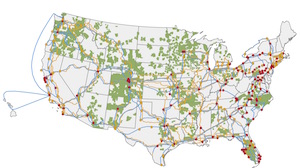
Click for the investor presentation.
CenturyLink announced an agreement to acquire Level 3 yesterday. Valued at $34 billion – a combination of cash and stock – the deal would combine two of the biggest wholesale bandwidth providers in the U.S. According to Bloomberg, Level 3 is the second biggest, behind AT&T, and CenturyLink ranks fifth.
Both companies have extensive long haul and metro fiber networks. CenturyLink, which has the legacy Bell systems previously owned by Qwest, has more business locations, but Level 3 has more fiber: 200,000 miles of it. The objective of the deal, according to a joint statement, is to improve the combined company’s competitive position in the business services market….
The combined company will have the ability to offer CenturyLink’s larger enterprise customer base the benefits of Level 3’s global footprint with a combined presence in more than 60 countries. In addition, the combined company will be positioned to further invest in the reach and speeds of its broadband infrastructure for small businesses and consumers.
As might be expected, executives from both companies expressed confidence that the deal would be approved, not only by their respective shareholders but also by regulators. Unlike AT&T’s acquisition of Time Warner, the CenturyLink/Level 3 marriage will be combed over by the Federal Communications Commission and state regulators, including the California Public Utilities Commission, in addition to going through the federal justice department’s standard anti-trust review.
Another difference between the two mega-deals is that combining AT&T and Time Warner is a vertical integration move – AT&T is buying one of its key suppliers – while CenturyLink’s acquisition of Level 3 would be a horizontal merger. Both companies have similar, and sometimes overlapping, business lines and assets. It’s true that CenturyLink would be in a stronger competitive position relative to AT&T and Verizon, but it would also mean that the wholesale bandwidth market would be concentrated into fewer hands.
Regulatory reviews are expected to take about a year to complete.
